This article refers to firmware 4.2.1 and higher. You can install the latest firmware from the ADVANCED > Firmware Updates page in the Barracuda Load Balancer web interface.
This article outlines implementation considerations when deploying the Barracuda Load Balancer in an environment subject to PCI Data Security Standard (PCI DSS) compliance. This article focuses on the requirements placed on the Barracuda Load Balancer for achieving PCI compliance, in an environment that includes the following:
- Barracuda Load Balancer
- Application Server
- Database Server
For PCI DSS Requirement 6.6 compliance and added application security, consider including a Barracuda Web Application Firewall in your deployment environment.
Efficient PCI Compliance
PCI Compliance applies to entities that process, store, or transmit cardholder data. The Barracuda Load Balancer intelligently distributes traffic among servers for efficient use of server resources, and provides server fail-over for High Availability. The Barracuda Load Balancer, as an underlying technology infrastructure in your network, does not directly manage or store cardholder data. However, it provides a secure environment for the transmission of all application data including cardholder data. For merchants subject to PCI DSS, this facilitates certification attainment.
According to section 4.1 of the Payment Card Industry (PCI) Data Security Standard v1.2, merchants handling credit card data are required to "...use strong cryptography and security protocols such as SSL/TLS or IPSEC to safeguard sensitive cardholder data during transmission over open, public networks.”
Deploying services behind the Barracuda Load Balancer simplifies your PCI compliance by relying on a secure, up-to-date PCI-compliant stack front-end for back-end servers. Additionally, the Barracuda Load Balancer provides risk mitigation and business continuity by relieving your certification process from full scanning, and operating system, middle-ware, and application update and patching on all your Internet-facing production servers which can result in downtime and administrator overhead.
Configure Front End SSL
Front-end SSL refers to the SSL implemented between the Barracuda Load Balancer and the client connecting to the Barracuda Load Balancer from the Internet. Configure SSL for each Service that requires compliance.
The use of SSL has the following security implications under PCI DSS compliance:
- Disables Secure Sockets Layer version 2 (SSLv2);
- Disallows "weak" cryptography;
- Quarterly PCI security vulnerability scans conducted against your external-facing PCI systems.
Without the first two measures, the scans are likely to fail, leading to falling out of compliance and the associated risks and consequences.
Barracuda Load Balancer provides secure SSL Offloading for your services. To enable this, log into the Barracuda Load Balancer web interface, go to the BASIC > Services page, and click Edit following the Service you wish to modify. In the edit screen, scroll to the SSL Offloading section:
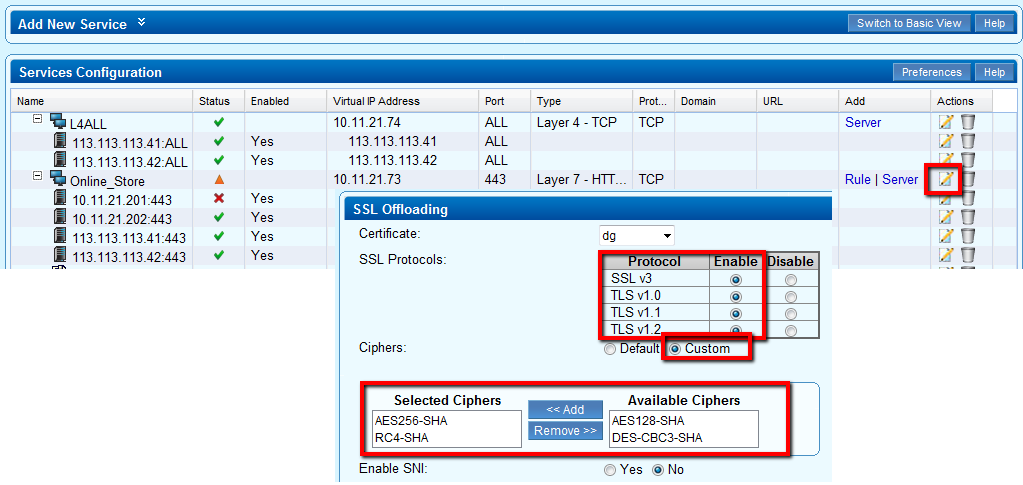
By default the Barracuda Load Balancer disables the deprecated ciphers and protocols, and is therefore "secure by default". As shown in the screenshot above, the Barracuda Load Balancer enables only:
- Secure Protocols – SSL v3, TLS v1.0/1.1/1.2
- Secure Ciphers – all weak and medium ciphers are disabled
Additionally, security researchers have recently identified new vulnerabilities in the SSL protocol; these are mitigated by the secure SSL stack in the Barracuda Load Balancer as shown in Table 1.
Table 1. SSL Protocol Vulnerabilities
| Vulnerability | Impact | Remediation |
|---|---|---|
| Insecure Renegotiation | High | Barracuda Load Balancer only supports secure renegotiation initiated by the Server. |
| BEAST Attack | Low | SSL v3 and TLS 1.0 may be vulnerable to this attack even when block ciphers are used; configure the Barracuda Load Balancer to prioritize or enforce stream (RC4) cipher suites. |
| CRIME Attack | Low | This attack exploits the protocol compression feature. By default, SSL compression is disabled in the Barracuda Load Balancer. |
Configuring Back-End SSL
Back-end SSL refers to the use of the SSL protocol to re-encrypt traffic between the Barracuda Load Balancer and the back-end servers. PCI mandates SSL when transmitting data over "open, public" networks; see Requirement 4: Encrypt transmission of cardholder data across open, public networks (page 35 of the PCI Data Security Standard). When the path between the Barracuda Load Balancer and the servers is within a secure zone, organizations are not mandated to re-encrypt the traffic assuming the “privacy” of the path can be demonstrated for compliance.
If your network architecture, environment, or the associated risk necessitates back-end SSL, go to the BASIC > Services page, click Edit following the Service you wish to modify, and update the SSL section as shown in the following image:
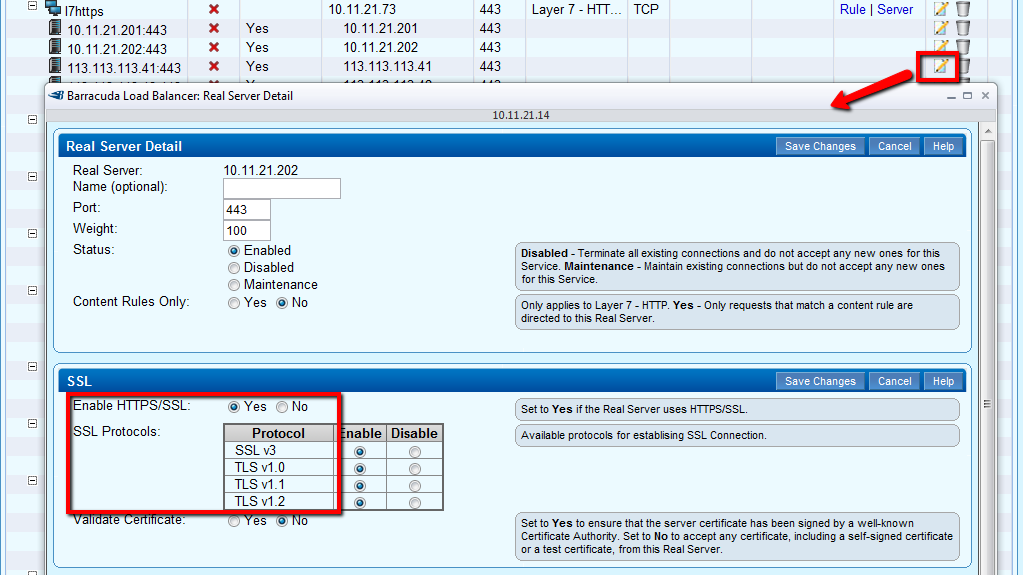
Back-end SSL uses the same secure SSL protocols and ciphers as front-end SSL.
Secure Certificates
Though PCI does not specify minimum certificate key sizes, Barracuda Network recommends a minimum of 2048 bit key strength when renewing certificates or deploying new services. Note that the National Institute for Standards and Technology (NIST) has mandated moving to 2048 bit certificates, which the Barracuda Load Balancer fully supports. Ensure that all SSL services, as well as the Management UI, employ strong certificates.
Secure the Web-based Management UI
Barracuda Networks recommends allowing the Management UI access only from the Management interface and disabling it from the WAN interface. This ensures that the Management UI is not exposed to external scanners and access is restricted to an internal, secure management network. To configure this, go to the BASIC > IP Configuration page, and update the WAN IP Configuration section as shown in the following image:
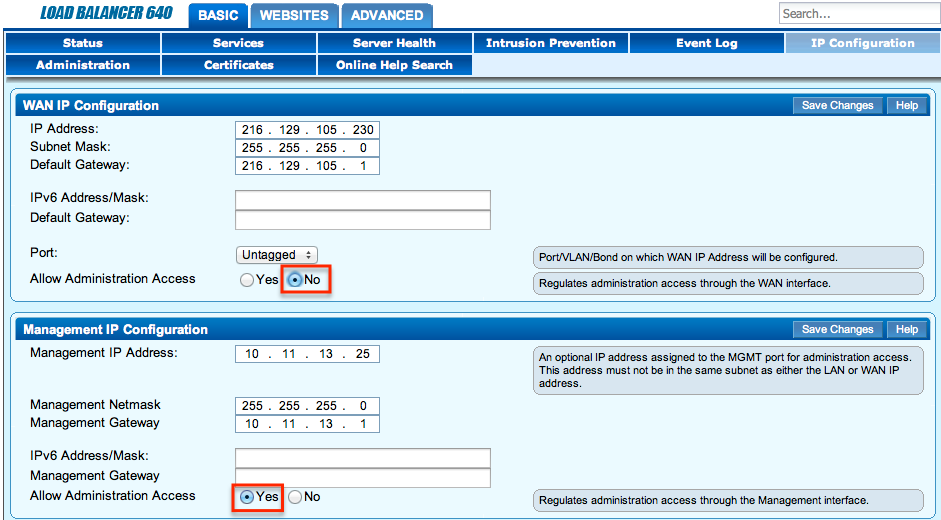
For additional security, restrict Web Interface access by setting HTTPS/SSL Access Only to Yes, and disable regular HTTP access on the ADVANCED > Secure Administration page. You can select a Private certificate if you have restricted access to a private network as in the screenshot shown above. If you choose to enable access via the WAN interface, ensure that you select a Trusted certificate instead.

Secure SNMP Access
To secure the SNMP access for compliance, go to the ADVANCED > SNMP Configuration page, and complete the following steps:
- In the SNMP Manager section, select the SNMP Version as v3.
- Provide a secure password for the admin user.
- Select SHA and AES as the Authentication Method and Encryption Method respectively; these are more secure than MD5 and DES.
- Restrict SNMP Access to an internal network via the Allowed SNMP IP/Range control:
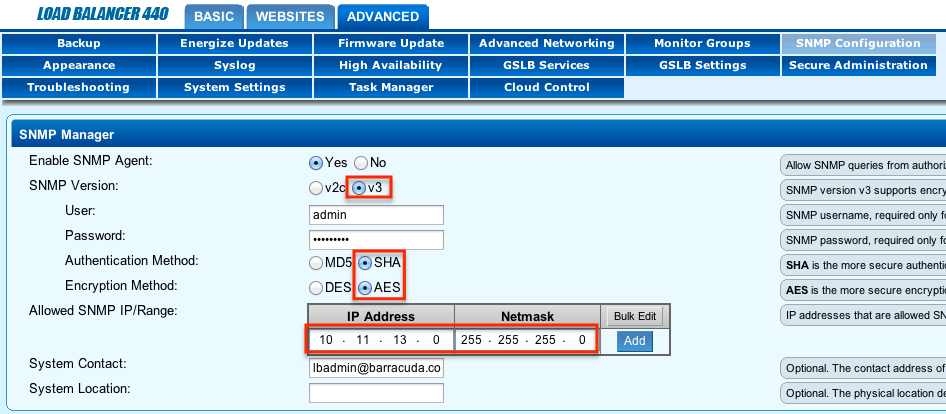
- If you choose to use SNMP v2c to support legacy SNMP clients, ensure that you change the default SNMP Community String:

Enable Syslog for Audit Compliance
To enable Syslog, go to the ADVANCED > Syslog page, enter the Syslog Server address, and click Add:
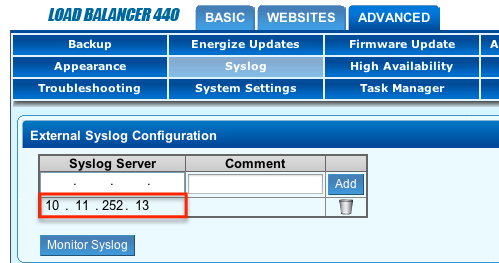
Ensure Password Security
Before you install and deploy one or more Barracuda Load Balancers, ensure that you have changed the default password on all devices. It is recommended that you have an organizational policy in place for setting passwords with a minimum strength that are distinct from personal passwords used by employees on the public Internet.
Enabling HTTPS/SSL only access to the web-based interface, as noted earlier in this article, further enhances credential security over public and private networks.
Encrypt All Configuration Backups
Ensure that all manual and automated backups are encrypted so that configuration and sensitive information is not compromised in the event the backup file is compromised. To configure encryption on all configuration backups, go to the ADVANCED > Backup page, and set Encrypt Backup File to Yes.

Specify a strong Backup Key using the same principals used for strong passwords. This key is required to decrypt or restore the backup configuration.
Additional PCI Compliance
Barracuda Networks is committed to security of its devices and helping customers achieve compliance. Barracuda Networks has additional best-of-breed security product offerings that can help you achieve additional PCI compliance cost effectively, especially for web application security, email encryption, anti-virus, and web filtering.
Customers evaluating Barracuda Networks products can be assured of security and compliance commitment throughout the product’s life cycles. For any issues or questions related to PCI compliance, contact Barracuda Networks Technical Support or your sales representative.
Scanner False Positives
Following are two false positives that some scanners have reported during PCI evaluations.
SNMP vulnerability
Some scanners incorrectly report that the Barracuda Load Balancer is susceptible to CVE 2002-0012 CVE 2002-0013 CVE2002-0053.
Barracuda Load Balancer includes a customized port of NET-SNMP version: 5.4.2.1, which is not susceptible to the vulnerabilities mentioned in the reports. Only versions of NET-SNMP prior to 4.2.2 are susceptible to these.
For additional information refer to CERT® Advisory CA-2002-03 Multiple Vulnerabilities in Many Implementations of the Simple Network Management Protocol (SNMP) available at http://www.cert.org/advisories/CA-2002-03.html.
If you encounter this false positive, submit the report to the scanning organization for validation.
Additionally, Barracuda Networks has implemented the following additional security measures as recommended by the security advisory:
- Ability to filter SNMP traffic from non-authorized internal hosts
- Ability to change default community strings
- Ability to disable SNMP service if not explicitly required
Insecure Cookies
The Barracuda Load Balancer inserts cookies for a service when the Persistence type is HTTP Cookies. Some scanners confuse these with application cookies and report them as insecure if the HTTP only or secure attribute is not set. You can configure both of these from the Persistence properties of a Service to avoid this false positive.
